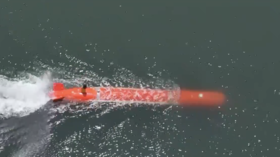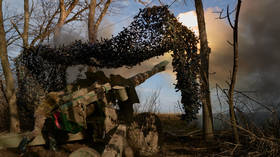MH17 downed in Ukraine: What has happened in 365 days since the crash
It has been a year since Malaysia Airlines flight MH17 tragically crashed in eastern Ukraine, killing all 298 passengers on board. Probes into disaster have been sluggish and secretive, fueling speculation concerning who brought down the plane and why.
July 17, 2014: MH17 downed in eastern Ukraine
The Malaysian Airlines flight MH17 left Amsterdam at 12:14 local time and was heading to Kuala Lumpur with 283 passengers and 15 crew members onboard a Boeing-777.
Here is my picture of Malaysia Airlines 9M-MRD taking off from Schiphol today. My thoughts are with pax and crew. pic.twitter.com/zuILsQCzy6
— Tom Warners (@SchipholSpot) July 17, 2014Malaysia Airlines lost contact with the plane as it flew over eastern Ukraine, which had been engulfed in a military conflict. The aircraft was expected to enter Russian airspace at 17:20 local time, but it never made it. The plane disappeared from radar, flying at an altitude of 10,000 meters (33,000 feet).
Malaysia Airlines flight #MH17 just before it disappeared over Ukraine. pic.twitter.com/xvDHsEQtkg
— Flightradar24 (@flightradar24) 17 июля 2014It was quickly established that the aircraft had crashed near the eastern Ukrainian town of Torez, which is located in the Donetsk region.
It was not long before horrific images of the crash started to appear on social media. Local residents who witnessed the tragedy, described gruesome experiences of witnessing bodies falling from the sky and parts of the plane’s fuselage still on fire.
Aleksandr, a local resident, told RT he heard “a roar and two explosions.” He went out to see what was going on. “[I] saw a spinning plane without a wing with something falling out of it. The plane was shot down,” he said. “There were explosions in the sky. And apart from the loud sounds of the plane itself, I heard the buzz which fighter jets make.”
July 18, 2014: The blame game kicks off
Before any investigation into the causes of the crash could be launched, a number of Western politicians and media outlets started blatantly accusing Russia – or what they called “pro-Russia rebels” of shooting down the plane with a surface-to-air missile.
''Putin' victim''...''Putin's killed my son''...
Kako su uigrani zapadni mediji, ovo kao media plan da imaju?! pic.twitter.com/svKXFD5FX3
— Bodljikava (@Bodljikava) July 19, 2014The British tabloid, The Sun, infamously covered its front page with a headline saying - “Putin’s missile.”
Putin´s missile !!!
#MH17#Boeing#MalaysiaAirlines
#Ukraine#Russie#Poutine
@RevolutionSyriepic.twitter.com/luVfc2DAeb
— Révolution Syrienne (@RevolutionSyrie) July 19, 2014Meanwhile, the US President Barack Obama talked of “increasing confidence” that the Malaysian plane was shot down by a Buk surface-to-air missile that was launched from rebel-controlled territory. To this date, a year on after the tragic incident, the US has not presented any substantial evidence to support this claim.
On July 18, the Ukrainian Security Service released what it called “intercepted phone conversations,” allegedly proving that Donetsk rebels shot down MH17 by mistake.
READ MORE: Unverified tape released by Kiev presented as ‘proof’ E. Ukraine militia downed MH17
The tapes could not be independently verified and were dismissed by Russian officials as being fakes.
To support its claims, the Ukrainian agency then published a photo, which was supposed to provide “proof” that a Russian Buk-M missile system had been on its territory. However, it turned out these photos were actually month old pictures of a Ukrainian Buk system. The images were quickly deleted without any explanation.
READ MORE: Bogus photos of ‘Russian’ air-defense systems in Ukraine debunked by bloggers
Notably, Kiev continued its military operation in the area amid numerous calls from the international community to impose ceasefire around the crash site. Russia expressed concerns over the continuing shelling in the region, saying that the Kiev authorities may be seeking to “destroy evidence,” which implicates their role in the crash. It took until July 29 for Ukrainian President Petro Poroshenko to finally say that government troops were ready to impose a ceasefire near Torez, which in reality, was never fully observed.
July 20-July 31, 2014: Data recorders, recovering bodies
Anti-government militias in the east of Ukraine managed to recover the plane’s data recorders from the crash site and passed them onto the Netherlands, who would eventually lead the international investigation. The team says they have found no evidence that the black box recorder was tampered with.
Tech elements resembling black boxes of #MH17 under guard in#Donetsk. Will be given only to intl experts. #borodaipic.twitter.com/CjYog5zCQt
— Roman Kosarev (@Kosarev_RT) July 20, 2014Monitors from the Organisation for Security and Co-operation in Europe (OSCE) cooperated with anti-government forces in attempting to recover the bodies from the crash site. The Netherlands lost more citizens during the tragedy than any other country, with 193 losing their lives. There were 43 victims, including 15 crew members from Malaysia, while 38 Australians were killed.
Monitors complete visit to Torez RR stn; observed 3 refrigerated wagons w/several dozen body bags said 2 B from #MH17pic.twitter.com/w6HM5lEdZF
— СММ ОБСЄ в Україні (@OSCE_SMM) July 20, 2014In the final week of July, aviation experts from Malaysia arrived in Donetsk, in the east of Ukraine, to investigate the crash.
Intimate candlelight vigil here in Kuala Lumpur for the 298 souls aboard #MH17pic.twitter.com/rtBpFWf774
— David Wright (@WrightUps) July 19, 2014By the end of the month, the bodies of the first victims from the MH17 crash had arrived in the Netherlands. On July 31, Dutch and Australian forensic teams managed to reach the crash site for the first time.
July 21, 2014: Moscow presents radar data showing Kiev jet tracking MH17
On July 21, the Russian Defense Ministry presented military radar data, which said it detected a Ukrainian SU-25 fighter jet gaining altitude towards the Boeing-777 on the day of the catastrophe. Moscow urged Kiev to explain why its jet was tracking the passenger plane. Ukraine refused to divulge this information.
The Defense Ministry added that at the moment of the MH17 crash, an American reconnaissance satellite was flying over eastern Ukraine. The ministry also urged the US to publish the data captured by the satellite.
In addition, MH17 crashed within the operating zone of the Ukrainian army’s Buk missile systems, which were stationed close to the crash zone. The Russian Defense ministry presented satellite images to back up its claims.
READ MORE: Ukrainian Su-25 fighter detected in close approach to MH17 before crash - Moscow
Meanwhile, the EU, which had been reluctant to implement economic sanctions against Moscow over the Ukrainian crisis for several months, decided to make the move after the MH17 tragedy. Key restrictions against Russia included closing EU capital markets to state-owned Russian banks, an embargo on arms sales to Russia, and restrictions on the supply of dual-use and energy technologies.
September, 2014: Dutch investigators release preliminary report
There are two parallel investigations into the disaster, both headed by the Dutch. The first is being carried out by the Dutch Safety Board and is looking into the cause of the crash. The second, a closed investigation being undertaken by several countries of the Joint Investigation Team (JIT), is a criminal inquiry.
The preliminary report into the causes of the crash released by the Dutch Safety Board on September 9 said that MH17 went down as a result of structural damage caused by a large number of high-energy objects that struck the Boeing from the outside. The Dutch investigators said, “there are no indications” that the tragedy was triggered “by a technical fault or by actions of the crew.”
The fact that there were many pieces of aircraft structure distributed over large
area indicated that the aircraft broke up in the air #MH17
— Onderzoeksraad (@Onderzoeksraad) September 9, 2014Damage was consistent with damage that would be expected from large number
of high-energy objects that penetrated the aircraft from outside.
— Onderzoeksraad (@Onderzoeksraad) September 9, 2014The cockpit voice recorder, the flight data recorder and data from air traffic control all suggested that the Malaysia Airlines plane was proceeding as normal until 13:20:03 GMT, after which the flight ended abruptly, the report added.
READ MORE: MH17 broke up in mid-air due to external damage - Dutch preliminary report
However, according to critics of the investigation, the report left too many questions.
On September 17, an investigation company Wifka, based in Schleswig-Holstein, north Germany said that it has been charged with investigating the case of why the plane crashed. The agency added that an anonymous client said they would pay $30 million to whoever was able to provide evidence that would identify who was behind the downing of the plane.
October, 2014: Chief Dutch prosecutor ‘open’ to air-to-air missile downing claims
On October 19, a report by Der Spiegel citing Germany’s BND foreign intelligence agency claimed that local militia shot down MH17. The BND was said to possess “ample evidence,” though none of it has been made public..
Meanwhile, the newspaper reported that the chief Dutch prosecutor investigating the crash said that he had not excluded the possibility that the aircraft might have been shot down from the air.
November, 2014: Malaysia excluded from probe
Only four months after the crash, the Dutch investigators began to transport more of the plane’s debris from the crash site, while more human remains were discovered. Human rights activists addressed the UN and the OSCE, warning that the investigation was being either delayed on purpose or suppressed.
Malaysia, the country that owned the Boeing-777 jet, was excluded from the Joint Investigation Team (JIT), which was carrying out a criminal probe into the downing of the plane. This move was interpreted as being due to the country’s political neutrality in the national media. The Netherlands, Belgium, Ukraine, and Australia, were the four nations making up the JIT.
December, 2014: Victims’ families address UN, urge to take over probe
Twenty relatives from Belgium, Germany, the Netherlands and the US addressed the Netherlands suggesting that the UN should take over the investigation into the downing of the passenger plane and blamed the Dutch for “completely botching” the fact-finding investigation and the legal framework of the case, Reuters reported on December 5. Several days later, the Netherlands rejected the demand.
Most passengers were Dutch nationality There were 9 other nationalities such as British, Australian & Malaysian #MH17pic.twitter.com/1LeaQfolx4
— Air Disasters (@AirCrashMayday) July 17, 2015READ MORE: Netherlands rejects MH17 relatives' request for UN investigation
At the same time a report made by The Sunday Times claimed that the European air traffic control regulator had urged Kiev to close the southeast of Ukraine for civilian aircraft days before the MH17 flight was downed. However, the plea was ignored by the local authorities.
January, 2015: Russia calls for preliminary MH17 probe results
The Russian Foreign Ministry accused the Western states of forgetting about the investigation of the MH17 tragedy, adding that Moscow wanted at least some preliminary results to be published.
“The West imposed sanctions [on Russia] under the pretext of the catastrophe of the Malaysian Boeing,” said Russian FM Sergey Lavrov on January 12, adding that Western countries have since “completely forgotten this problem.”
March 2015: Debate reignited by SU-25 jet’s chief designer
Kiev-born Soviet and Russian aircraft designer Vladimir Babak told the German media that the SU-25 jet – spotted by Moscow tracking MH17 – allegedly did not have the capability to shoot down a passenger plane. He said the fighter jet could have successfully attacked the Boeing at an altitude of 3,000-4,000 meters, but not at the plane’s altitude of 10,500 meters. He added that air-to-air missiles would have only damaged the Boeing – not completely destroying it, while still in the air.
Генконструктор Су-25: Штурмовик не мог сбить "Боинг" рейса MH-17 http://t.co/cVb4s2AckMpic.twitter.com/AFeqYRKYbb
— Главный Либерал (@ChiefLiberal) March 11, 2015However, RT spoke to former pilots, who disagreed with Babak’s views. On the contrary, they said that the SU-25 is capable of flying at high altitudes and can carry powerful missiles.
READ MORE: Could SU-25 fighter jet down a Boeing? Former pilots speak out on MH17 claims
March, 2015: Reuters ‘witness report’ on MH17
Reuters published a report of witnesses’ statements, in which people said they had seen a rocket fired at the time of Malaysian Boeing crash. Moscow condemned the report saying that it was an attempt at “distorting facts, enforcing versions on what could have happened… with some based on openly dirty intentions.”
However, a resident from the Lugansk Region, whom Reuters cited as saying he saw a surface-to-air missile launched from rebel-held territory on the day MH17 was downed, told RT, the news agency misinterpreted what he said.
June, 2015: Russia identifies key witness in MH17 downing
Malaysia Airlines appointed a new CEO Christoph Mueller, who announced the company is “technically bankrupt.”
Meanwhile, the Buk missile manufacturer Almaz-Antey conducted its own probe into the MH17 tragedy. The investigation, while focusing on a Buk missile theory, did not exclude the possibility that the Boeing was hit by another type of weapon, such as an air-to-air missile.
Also in June, a British online investigative group Bellingcat accused Russia of altering satellite images from the MH17 disaster. However, image forensics experts have discredited the analysis.
Next we're thinking we'll look at the launch site and the field with track marks on July 16th, see if they're there pic.twitter.com/SUDnud4ool
— bellingcat (@bellingcat) June 2, 2015READ MORE: ‘Reading tea leaves’: German expert questions Bellingcat’s MH17 photo scoop
Meanwhile, Russia’s Investigative Committee (IC) has been conducting its own investigation into the crash. On June 3, the IC identified the key witness to the MH17 crash as Evgeny Agapov, an aviation armaments mechanic in the Ukrainian Air Force. Agapov testified that on July 17, 2014 a Ukrainian Sukhoi SU-25 jet aircraft piloted by Captain Voloshin “set out for a military task” and returned without ammunition. Agapov implied that an air-to-air missile was missing and claimed he overheard Voloshin say to his colleagues that some plane was “in the wrong place at the wrong time.”
READ MORE: Russian investigators reveal identity of key witness in MH17 crash
July, 2015: Malaysia calls for international tribunal
On July 14, Malaysia submitted a draft resolution to the UN Security Council to establish an international tribunal to prosecute those behind the crash.
Russia criticized Malaysia’s demand and on July 16, the Russian President Vladimir Putin described the calls as premature.
#Lavrov: All our attempts, to organise a discussion of the investigation, were blocked by the countries that are now advocating a tribunal
— MFA Russia (@mfa_russia) July 17, 2015More unconfirmed “leaked” reports surfaced in the first weeks of July. CNN published an account on July 15 citing anonymous officials allegedly familiar with the final confidential Dutch report on the crash. It claimed that the investigators blamed the rebels for the attack.
READ MORE: US officials say Ukraine rebels behind MH17 downing, Dutch team cannot confirm
The Dutch Safety Board spokesperson told RT, the investigators “cannot confirm” this information. The spokesperson added that the report on the immediate causes of the tragedy is due to be released in early October.
On July 15, the Russian IC repeated that the version in which the Malaysia Airlines flight MH17 was downed by an air-to-air missile was a priority for them. It also cited experts as establishing that the missile was not manufactured in Russia.
READ MORE: MH17 likely downed by air-to-air missile, not Russian made – Investigative Committee
Meanwhile, the Russian Federal Air Transport Agency rebuked claims that the plane could have been shot down by a ground-to-air missile from the areas controlled by anti-government militias in the east of Ukraine.
LISTEN MORE:













